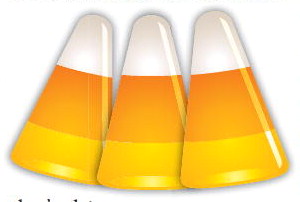Candy Corn


Ah, candy corn! That sugary tricolor treat that I love is back on shelves again this year, and I’ve already eaten a pound of it — maybe even two pounds.
These confections tempt me every October. In fact, I look forward to seeing the bags show up in the grocery stores around town at the end of the summer, filled with pyramid- shaped candies layered in three colors — yellow at the base, orange in the middle, and white at the top. There are also bags containing miniature mellowcreme pumpkins and something referred to as, “Indian corn,” with their brown layers and notes of chocolate.
The flavor and texture are what draw me in. It’s like eating sweetened, buttery wax — though that may not sound very appetizing to you. Like a candy corn addict, I can’t resist eating it by the handfuls, and once I get started, I can’t stop, and then I find that I’ve eaten too much and feel miserable. Sometimes I have to lie down for a while to recover from the sugar rush. Everyone has their vice, and one of mine is consuming candy corn. I’m powerless to its spell.
In the wonderful world of candy corn, I prefer Brach’s brand, but I’m not picky and have been known to eat any brand of the stuff that’s in front of me. I’ve read that Brach’s boasts 85 percent of the total share of the candy corn industry during the Halloween season — making approximately 7 billion pieces of candy corn per year. That’s a lot! And so, I feel that Brach’s must know what they’re doing. But the story of candy corn began way back in the 1880s, long before people considered the nutritional value of food before they ate something. It was the brainchild of George Renninger, an employee of the Wunderle Candy Company. Originally called “Chicken Feed,” this treat was marketed with a big rooster on the package and the charming tagline, “Something worth crowing for.” It was an era when agriculture was king, and so the cornkernel- shaped candy made sense.
Candy corn’s original harvest vibe resonated with the autumn spirit, and as Halloween embraced commercialism with open arms in the 1960s and 1970s (my childhood years, when I first fell in love with it), so, too, did my beloved candy corn. A Halloween treat was born, because nothing says “spooky” more than color- coded high fructose corn syrup.
Yes, I know it’s unhealthy for me. Still, a little candy corn here and there isn’t going to kill me, right? Let’s hope not. I’d hate for that line to be in my obituary: She passed away peacefully surrounded by loving family members and empty bags of candy corn.
All joking aside, in the end, candy corn remains one of those nostalgic treats that sparks both fond memories and heated debates. Folks tend to be divided into three camps: lovers like me, haters, and those who just tolerate the stuff because eating it has become an October rite of passage, like collecting red maple or golden oak leaves, attending a fall festival, or carving pumpkins. Whether you love it or leave it, there’s no denying its place in fall’s fun festivities — a sweet symbol of Halloween traditions passed down through generations.
So as a chill fills the air, the leaves change color, and people ready their pumpkins and costumes, candy corn will continue to make its annual appearance, reminding us all that some seasonal delights are worth savoring without any thought of caloric content. As for me, I’ll continue to eat it, whether by the handful, or kernel by kernel, or color by color, because I just can’t stop.







out of
Posted on